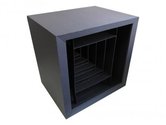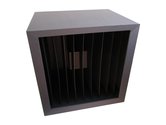John Hurrell – 5 November, 2013
When you look closely at these roughly made mock ups you soon realise they are made of painted cardboard and foamboard, not the envisaged steel, hardboard or mdf. Unlike Polounine's slick computer drawings, they look battered and impermanent. The parallel internal planes are curved and wonky, the corner mitres far from fastidious, and the structural emphasis is as if the cube were a variety of dish or tray: an emitter or receiver positioned within right angled forms and not a parabola.
Auckland
Oleg Polounine
Reverse Engineering
16 October - 4 December 2013
These three dark grey cubes, presented by Oleg Polounine, attached directly to the glass of the Corner window (intersection of Karangahape Rd and Edinburgh St) are investigative ‘prototypes’, tentative models where making comes first chronologically and in depth analysis second. Where the sculpture is constructed partly by logic and partially by intuition, and then assessed, its capabilities discovered further down the line and accentuated accordingly - instead of predetermined function rigidly dictating form from start to finish.
Rob Garrett, the curator of this space, writes about them here. Reverse engineering seems to be based on an a posteriori process, not a priori (as exemplified by Sol LeWitt): empirical data being emphasised, not concept - though the two I think are hard to pry apart and a posteriori can be used to revise ideas. These notions are also entangled with the idea of post-object art, the view of art being independent of a palpable, material presence.
When you look closely at these roughly made mock ups - boxes with one side exposed - you soon realise they are made of painted cardboard and foamboard, not the envisaged steel, hardboard or mdf. Unlike Polounine’s slick computer drawings shown here, they look battered and impermanent. The parallel internal planes are curved and wonky, the corner mitres far from fastidious, and the structural emphasis as if the cube were a variety of dish or tray: an emitter or receiver positioned within right angled forms and not a parabola. Another is grilled with flat planes, as if showing a smaller cube in a cage - it could be about the hermetic art world. The works all play with infinite regress.
One might speculate and claim that there is some sort of metaphor at work here, about how ideas are received by an individual, or disseminated by them, or how the art world can be insular in its focus.
Perhaps more importantly, Polounine‘s project draws attention to the process of making and the difficulty of setting up a fixed idea before creating the object, the problems of allowing a conceptual template to determine all aspects. It permits flexibility, not so much play but through scrutinising what you’ve ended up with, analysing as a means of not only re-examining your starting off point, but also opening up a cluster of newly discovered alternative making possibilities that can be explored further and tinkered with.
John Hurrell




 Advertising in this column
Advertising in this column Two Rooms presents a program of residencies and projects
Two Rooms presents a program of residencies and projects



This Discussion has 0 comments.
Comment
Participate
Register to Participate.
Sign in
Sign in to an existing account.